
Texas
Texas Property Tax Plan Mimics California’s Damaging Prop 13
December 19, 2025 • By Neva Butkus, Rita Jefferson

This proposal would disrupt the state’s housing market and jeopardize local revenues while doing very little to help workers and families struggling to pay their property tax bills – just as Prop 13 did in California.
State Rundown 12/17: Tax Policy ‘Naughty or Nice’ List Has Late Entrants
December 17, 2025 • By ITEP Staff

With a little over a week left, some states are solidifying their spots on the tax policy “naughty or nice” list.
The Nation: Texas Republicans Are Doubling Down on Banning Capital Gains Taxes
October 31, 2025
If passed, the constitutional amendment would lock out a potential source of future state funding and disproportionately benefit wealthy households. Read more.
Every Texan: Texas Taxes Are Upside-Down. Big Tax Cuts Don’t Help.
March 18, 2025
Texas’ tax system is upside-down. When it comes to funding our public services, schools, and state and local governments, Texans with lower incomes are expected to pay more than their fair share. Read more.
Every Texan: Current Border Militarization Operations Are a Wasteful Attempt at Deterrence
January 31, 2025
There is little return to show on past border militarization investments. Beginning in 2021, the Governor launched a multi-year campaign called Operation Lone Star that, in part, allowed his Trusteed Programs office to distribute billions of dollars in grants to once resource-starved border communities. SB 1 prepares to double down on this failed investment with […]
Texas: Who Pays? 7th Edition
January 9, 2024 • By ITEP Staff
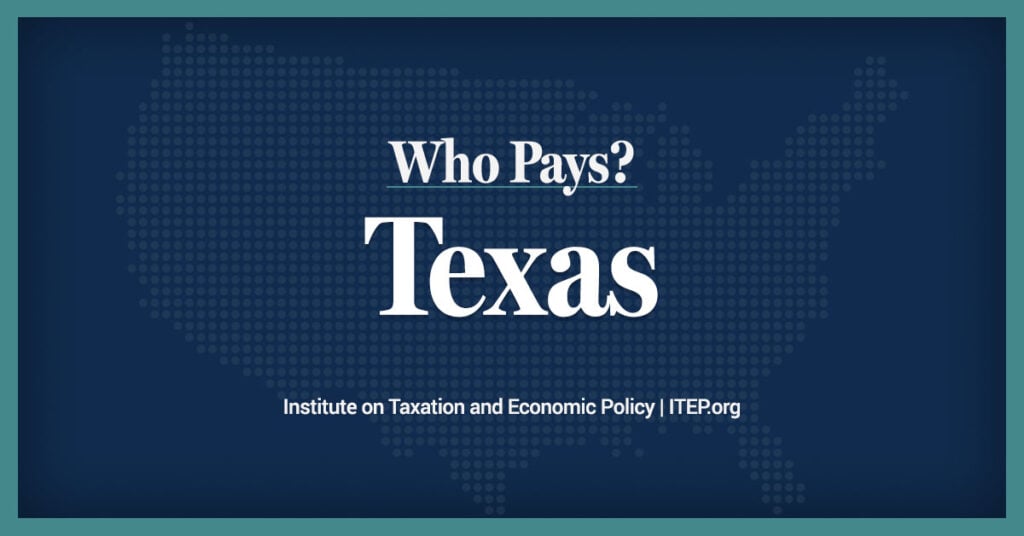
Texas Download PDF All figures and charts show 2024 tax law in Texas, presented at 2023 income levels. Senior taxpayers are excluded for reasons detailed in the methodology. Our analysis includes nearly all (99.5 percent) state and local tax revenue collected in Texas. State and local tax shares of family income Top 20% Income Group […]
2023’s State and Local Tax Ballot Measures: Voters to Weigh in on Property Taxes, Wealth Taxes, and More
October 24, 2023 • By Jon Whiten

Even in this slow year for candidate elections, the decisions that voters in states and cities make could strengthen or weaken revenue for needs in their communities and could change how taxes are distributed across the income spectrum. In the places where tax fairness is on the ballot, much is at stake.
Every Texan: Proposition 3 Will Maintain Texas’ Extreme Wealth Inequality
October 21, 2023
We all benefit when everyday Texans, regardless of where we live or what we look like, have a fair opportunity to prosper. Contrarily, a state tax system designed to favor the ultra-wealthy undermines all of us. In Texas, the wealth gap is so extreme that 66 billionaires living in the state own more wealth than 70% […]
Washington Examiner: Think tank: Texas Isn’t a Low-tax State if You’re Poor
October 23, 2018
Carl Davis for the Institute on Taxation and Economic Policy: [ M]any states traditionally considered to be “low-tax states” are actually high-tax for their poorest residents. The “low tax” label is typically assigned to states that either lack a personal income tax or that collect a comparatively low amount of tax revenue overall. But a focus on these measures can cause lawmakers to overlook the fact that state tax systems impact different taxpayers in very different ways, and that low-income taxpayers in particular often do not experience these states as being even remotely “low tax.”
CPPP: The Staggering Unfairness of Our State Tax System
October 19, 2018
Here’s one way to think about it: Families at the top of the income ladder receive 20 percent of all personal income in Texas, but pay only 8.5 percent of all state and local taxes. Families at the bottom of the scale receive only three percent of all income, but pay 5.7 percent of all taxes.
Low Tax for Whom? Texas is a “Low Tax State” Overall, But Not for Families Living in Poverty
October 17, 2018 • By ITEP Staff
Texas’s tax system has vastly different impacts on taxpayers at different income levels. For instance, the lowest-income 20 percent of Texans contribute 13 percent of their income in state and local taxes — considerably more than any other income group in the state. For low-income families, Texas is far from being a low tax state; in fact, it is tied with Arizona as the sixth highest-tax state in the country for low-income families.
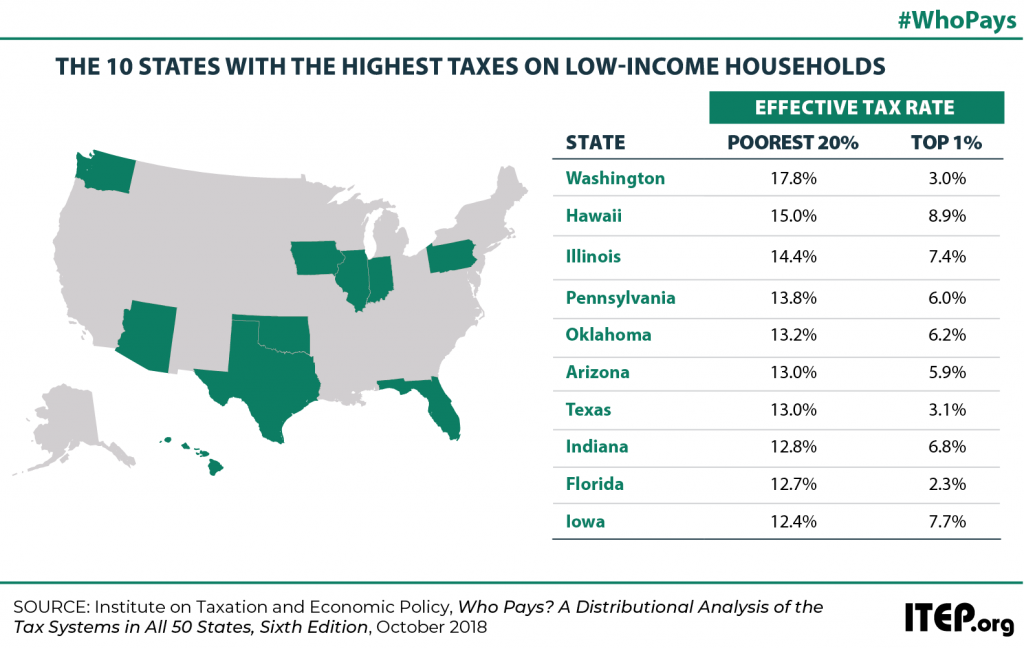
ITEP analysis reveals that many states traditionally considered to be “low-tax states” are actually high-tax for their poorest residents. The “low tax” label is typically assigned to states that either lack a personal income tax or that collect a comparatively low amount of tax revenue overall. But a focus on these measures can cause lawmakers to overlook the fact that state tax systems impact different taxpayers in very different ways, and that low-income taxpayers often do not experience these states as being even remotely “low tax.”
Texas: Who Pays? 6th Edition
October 17, 2018 • By ITEP Staff

TEXAS Read as PDF TEXAS STATE AND LOCAL TAXES Taxes as Share of Family Income Top 20% Income Group Lowest 20% Second 20% Middle 20% Fourth 20% Next 15% Next 4% Top 1% Income Range Less than $20,900 $20,900 to $35,800 $35,800 to $56,000 $56,000 to $98,200 $98,200 to $216,000 $216,000 to $617,900 over $617,900 […]
Tax Cuts 2.0 – Texas
September 26, 2018 • By ITEP Staff
The $2 trillion 2017 Tax Cuts and Jobs Act (TCJA) includes several provisions set to expire at the end of 2025. Now, GOP leaders have introduced a bill informally called “Tax Cuts 2.0” or “Tax Reform 2.0,” which would make the temporary provisions permanent. And they falsely claim that making these provisions permanent will benefit […]
Center for Public Policy Priorities: The National Dream Act: What’s at stake for Texas?
December 18, 2017
Researchers estimate that approximately 177,000 young Texas immigrants are potentially eligible for DACA, and they currently contribute a total of $241 million to local and state taxes annually through sales and excise taxes, property taxes and income tax. Without the national Dream Act, Texas can expect to lose at least $79 million in state and […]
How the Final GOP-Trump Tax Bill Would Affect Texas Residents’ Federal Taxes
December 16, 2017 • By ITEP Staff
The final tax bill that Republicans in Congress are poised to approve would provide most of its benefits to high-income households and foreign investors while raising taxes on many low- and middle-income Americans. The bill would go into effect in 2018 but the provisions directly affecting families and individuals would all expire after 2025, with […]
How the House and Senate Tax Bills Would Affect Texas Residents’ Federal Taxes
December 6, 2017 • By ITEP Staff
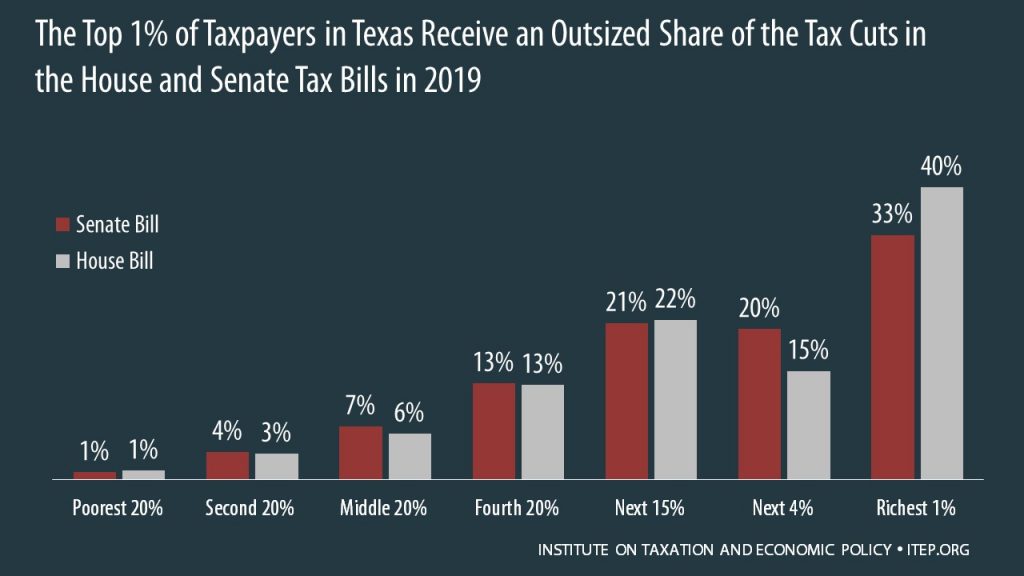
The House passed its “Tax Cuts and Jobs Act” November 16th and the Senate passed its version December 2nd. Both bills would raise taxes on many low- and middle-income families in every state and provide the wealthiest Americans and foreign investors substantial tax cuts, while adding more than $1.4 trillion to the deficit over ten years. The graph below shows that both bills are skewed to the richest 1 percent of Texas residents.
House Tax Plan Offers an Exceptionally Bad Deal for California, New York, New Jersey, and Maryland
November 14, 2017 • By Carl Davis
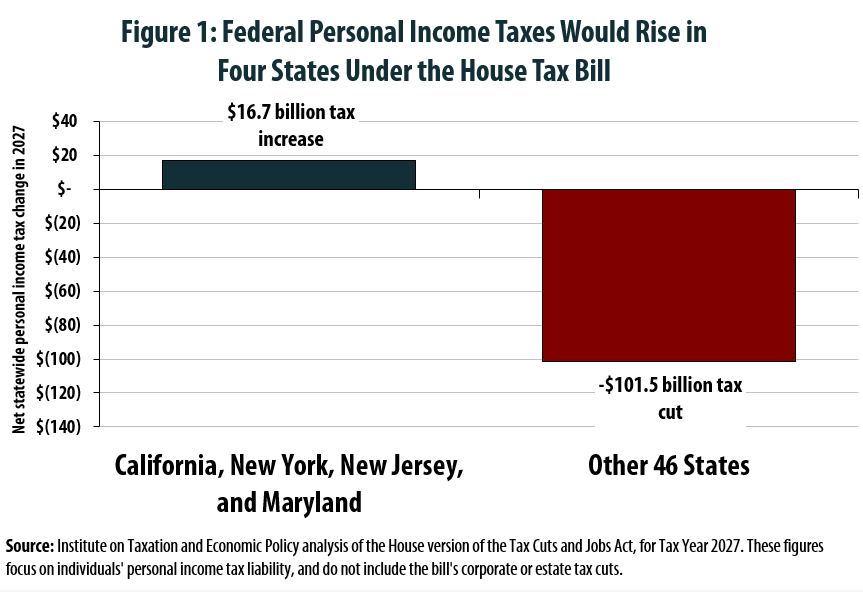
An ITEP analysis reveals that four states would see their residents pay more in aggregate federal personal income taxes under the House’s Tax Cuts and Jobs Act. While some individual taxpayers in every state would face a tax increase, only California, New York, Maryland, and New Jersey would see such large increases that their residents’ overall personal income tax payments rise when compared to current law.
How the Revised Senate Tax Bill Would Affect Texas Residents’ Federal Taxes
November 14, 2017 • By ITEP Staff

The Senate tax bill released last week would raise taxes on some families while bestowing immense benefits on wealthy Americans and foreign investors. In Texas, 54 percent of the federal tax cuts would go to the richest 5 percent of residents, and 8 percent of households would face a tax increase, once the bill is fully implemented.
How the House Tax Proposal Would Affect Texas Residents’ Federal Taxes
November 6, 2017 • By ITEP Staff
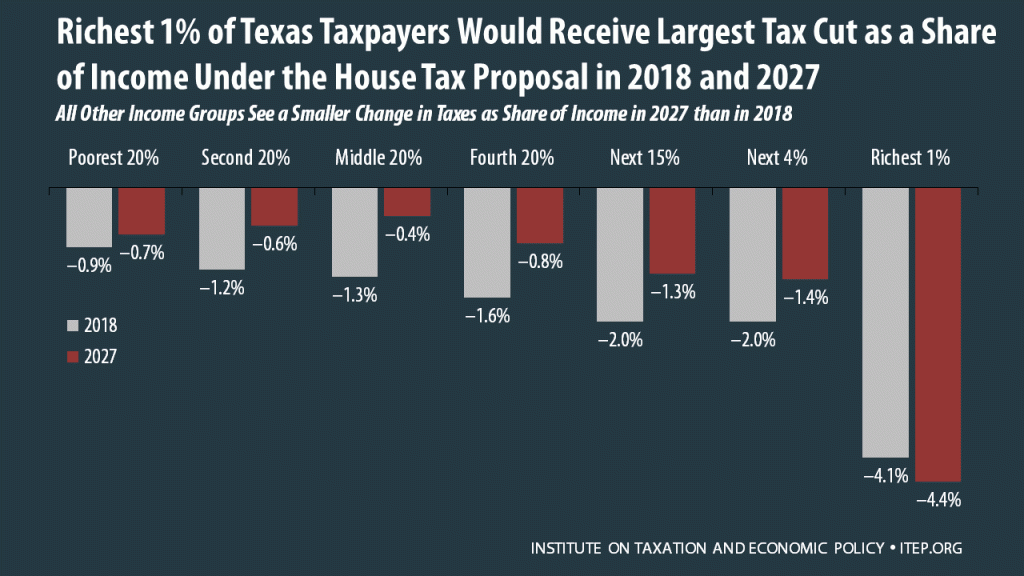
The Tax Cuts and Jobs Act, which was introduced on November 2 in the House of Representatives, includes some provisions that raise taxes and some that cut taxes, so the net effect for any particular family’s federal tax bill depends on their situation. Some of the provisions that benefit the middle class — like lower tax rates, an increased standard deduction, and a $300 tax credit for each adult in a household — are designed to expire or become less generous over time. Some of the provisions that benefit the wealthy, such as the reduction and eventual repeal of the estate…
GOP-Trump Tax Framework Would Provide Richest One Percent in Texas with 64.4 Percent of the State’s Tax Cuts
October 4, 2017 • By ITEP Staff
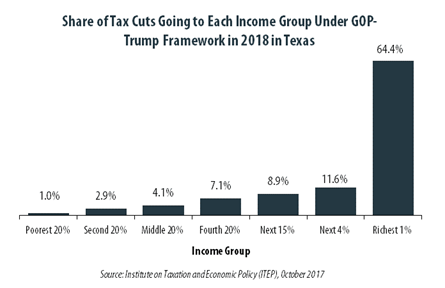
The “tax reform framework” released by the Trump administration and congressional Republican leaders on September 27 would not benefit everyone in Texas equally. The richest one percent of Texas residents would receive 64.4 percent of the tax cuts within the state under the framework in 2018. These households are projected to have an income of at least $696,400 next year. The framework would provide them an average tax cut of $119,040 in 2018, which would increase their income by an average of 5.9 percent.
Dallas Fed: Texas Taxes: Who Bears the Burden?
September 26, 2017
...Overall, the state’s tax system is less equal across income quintiles than the national average. A key reason is the state’s reliance on the sales tax, which as a share of income is 8.6 percent for those in the bottom quintile but only 2.2 percent in the top quintile...
State Rundown 8/23: Few Lingering Budget Debates Cannot Linger Much Longer
August 23, 2017 • By ITEP Staff
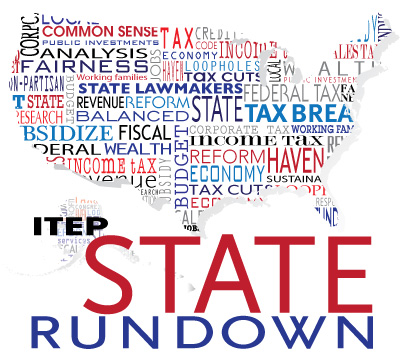
This week, Oklahoma lawmakers learned they'll need to enter a special session to balance their budget and that they'll likely face a lawsuit over their low funding of public education. Pennsylvania's budget stalemate is also coming to a head as the state literally runs out of funds to pay its bills. And Amazon's tax practices are in the news again as the company has been sued in South Carolina.
In Texas 51.6 Percent of Trump’s Proposed Tax Cuts Go to People Making More than $1 Million
August 17, 2017 • By ITEP Staff
A tiny fraction of the Texas population (0.3 percent) earns more than $1 million annually. But this elite group would receive 51.6 percent of the tax cuts that go to Texas residents under the tax proposals from the Trump administration. A much larger group, 46.2 percent of the state, earns less than $45,000, but would receive just 3.7 percent of the tax cuts.

This week, Rhode Island lawmakers agreed on a budget, leaving only three states – Connecticut, Pennsylvania, and Wisconsin – without complete budgets. Texas, however, remains in special session and West Virginia could go back into another special session over tax issues. And in New York City, the mayor proposes a tax on the wealthy to […]
